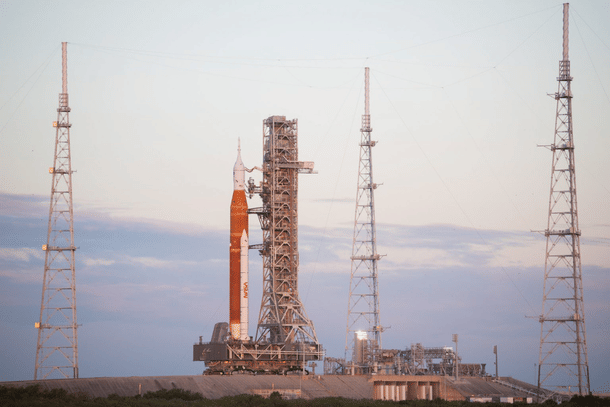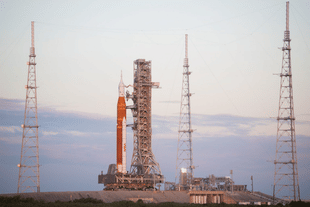Science
Artemis I: NASA's Mega Moon Rocket At Launch Pad For 14 November Lift-off
Karan Kamble
Nov 07, 2022, 11:59 PM | Updated Nov 08, 2022, 01:32 PM IST
Save & read from anywhere!
Bookmark stories for easy access on any device or the Swarajya app.


Update, 8 November (IST): NASA is monitoring the subtropical storm Nicole. The SLS rocket and Orion will remain at launch pad 39B, while NASA keeps a close eye on the weather and implements checklists and preparations as part of hurricane preparedness.
The Space Launch System (SLS) rocket and Orion spacecraft for the Artemis I mission of the National Aeronautics and Space Administration (NASA) are just under a week away from a much-delayed historic launch attempt.
Artemis I is an uncrewed flight test to launch SLS and send Orion around the Moon and back.
The mission will see the Orion crew capsule, this time uncrewed, shooting for the Moon for an unprecedented lunar swing-by, ending in a planned splashdown in the Pacific Ocean.
A successful Artemis I mission will provide the necessary confidence for NASA to embark on future lunar missions, including landing the first woman and first person of colour on the surface of the Moon no earlier than 2025, and destinations even further away.
They have a beast of a machine for the purpose — the SLS is the biggest launch vehicle ever developed by NASA.
The Moon-bound integrated system has been parked at launch pad 39B at NASA’s Kennedy Space Center in Florida since 4 November.
It had been rolled back to the vehicle assembly building towards the end of September — foregoing the 27 September launch opportunity — based on weather predictions associated with Hurricane Ian.
Once it was cleared to head back to the launch pad, the integrated rocket and spacecraft system took almost nine hours to gingerly cover the over 6.5-kilometre distance between the vehicle assembly building and the launch pad.
It will remain there for a few days as preparations continue. The launch of the SLS and Orion will be attempted within a 69-minute window starting 12.07 am Eastern Standard Time (10.37 am India time) on 14 November.
"Teams will continue working to configure SLS and Orion for the upcoming Nov. 14. launch attempt," the latest, 4 November update says.
A launch on 14 November would result in a mission duration somewhere between 25 and 26 days, with a splashdown expected in the Pacific Ocean on 9 December.
Back-up launch opportunities are set for 1.04 am on 16 November and 1.45 am on 19 November. Both these days will present two-hour launch windows. The launch window for the month closes on 27 November.
The historic liftoff has had to be held back on a few occasions since its very first take-off opportunity on 29 August was scrubbed after an engine bleed couldn't be remedied.
Unfortunately, the engines weren’t able to sit within the temperature range needed for lift-off on the maiden try. “We don’t launch until it’s right,” NASA Administrator Bill Nelson had said soon after.
After a quick turnaround, 3 September was set as the next launch opportunity. However, come that day, the attempt was once again scrubbed after teams encountered a liquid hydrogen leak while loading the propellant into the core stage of the SLS rocket.
Thereafter, 23 September was set as the next possible date for launch before it was adjusted to 27 September. However, fear for the safety and protection of both the Moon rocket as well as NASA employees on account of the tropical storm Ian led NASA to stand down from launch.
In the meantime, a cryogenic demonstration test was carried out on 21 September and "all objectives" were reportedly met.
The Moon rocket was rolled back slowly, starting late night on 26 September, to the vehicle assembly building.
A couple of days later, Ian struck.
It became the fifth-strongest hurricane on record to strike the United States. It was the strongest hurricane to hit Florida since Michael in 2018. The hurrican was downgraded to a tropical storm in a day's time, but not without lashing Florida with extreme rainfall.
Thankfully, the Kennedy area faced minimal impact from the hurricane.
An official update on 12 October provided the next launch date of 14 November.
"Inspections and analyses over the previous week have confirmed minimal work is required to prepare the rocket and spacecraft to roll out to Launch Pad 39B at Kennedy Space Center in Florida following the roll-back due to Hurricane Ian," the statement said.
After about a month's stay in the vehicle assembly building, the integrated rocket and spacecraft system left for launch pad 39B and arrived there on 4 November.
"We’re confident as we head into this next #Artemis I launch attempt," tweeted Jim Free, NASA’s Associate Administrator for Exploration Systems Development, on the upcoming, 14 November launch opportunity.
The mega Moon rocket must be raring to go.
Also Read: Artemis I: The First Test For Space Travel Back To The Moon, Explained
Karan Kamble writes on science and technology. He occasionally wears the hat of a video anchor for Swarajya's online video programmes.




